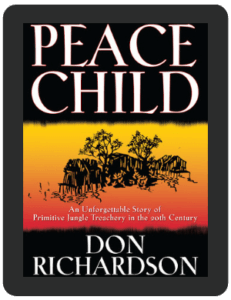Peace Child
by Don Richardson | Book Summary
|
Author: Don Richardson |
The Sawi of Western New Guinea, like many of these tribes, lead an existence totally alien to life as we know it in the Western world. But more unique to the Sawi is a ghastly, horrifying cultural tradition: the worship of treachery. Betrayal, murder, and cannibalism are sanctified, a time-honored custom and subject of heroic mythology. How, in a culture like that of the Sawi, can God's divine light be made known? The answer is not simply a matter of exposure and preaching — the Sawi bring an almost unimaginably different vision of reality to the table, a total reversal of Western moral logic. How could Scripture mean anything to these people, who are bored by Jesus and intoxicated by Judas? For whom Judas is the hero of the New Testament? For Don Richardson, a Christian missionary sent to Western New Guinea, the answer was the 'peace child,' an old Sawi tradition that almost uncannily parallels the doctrine of the Incarnation. In a mammoth effort of linguistic investigation, philosophical inquiry, and empathy, Richardson managed to uncover a handful of key concepts in Sawi culture that bridged the gap between the Christian and the Sawi and, beneath all the treachery and violence, helped find God in the hearts of His lost children. |
Don Richardson was a Christian missionary from Canada who worked with the people of Western New Guinea in Indonesia. His books include Secrets of the Koran, Lords of the Earth, and Eternity in Their Hearts. He studied at the Summer Institute of Linguistics as well as the Prairie Bible Institute, and later received an honorary doctorate from Biola University. After his studies, Richardson studied the world of Islam for over 30 years.
In 1962, he left with his wife to spread the message of the gospel to the Sawi tribe in New Guinea. The mission was exceedingly dangerous, as the Sawi people were ultraviolent and cannibalistic. Richardson ended up dedicating 15 years of his life to fostering communication between Christian missions and the Sawi people, building an alphabet for the Sawi language and eventually penning a translation of the New Testament. Over half of the Sawi people accepted Christ as their Lord and Savior.
Peace Child
by Don Richardson
[ Book Summary ]
| Author | Don Richardson |
| Publisher | Bethany House |
| Date | 1976 |
| Pages | 256 |
Overview:
There still remain out there, in the remote, uncharted territories where few men dare to tread, a smattering of tribes and villages still living with Stone Age-era tools and a primitive understanding of the natural world.
The Sawi of Western New Guinea, like many of these tribes, lead an existence totally alien to life as we know it in the Western world. But more unique to the Sawi is a ghastly, horrifying cultural tradition: the worship of treachery. Betrayal, murder, and cannibalism are sanctified, a time-honored custom and subject of heroic mythology.
How, in a culture like that of the Sawi, can God's divine light be made known? The answer is not simply a matter of exposure and preaching — the Sawi bring an almost unimaginably different vision of reality to the table, a total reversal of Western moral logic. How could Scripture mean anything to these people, who are bored by Jesus and intoxicated by Judas? For whom Judas is the hero of the New Testament?
For Don Richardson, a Christian missionary sent to Western New Guinea, the answer was the 'peace child,' an old Sawi tradition that almost uncannily parallels the doctrine of the Incarnation. In a mammoth effort of linguistic investigation, philosophical inquiry, and empathy, Richardson managed to uncover a handful of key concepts in Sawi culture that bridged the gap between the Christian and the Sawi and, beneath all the treachery and violence, helped find God in the hearts of His lost children.
Don Richardson was a Christian missionary from Canada who worked with the people of Western New Guinea in Indonesia. His books include Secrets of the Koran, Lords of the Earth, and Eternity in Their Hearts. He studied at the Summer Institute of Linguistics as well as the Prairie Bible Institute, and later received an honorary doctorate from Biola University. After his studies, Richardson studied the world of Islam for over 30 years.
In 1962, he left with his wife to spread the message of the gospel to the Sawi tribe in New Guinea. The mission was exceedingly dangerous, as the Sawi people were ultraviolent and cannibalistic. Richardson ended up dedicating 15 years of his life to fostering communication between Christian missions and the Sawi people, building an alphabet for the Sawi language and eventually penning a translation of the New Testament. Over half of the Sawi people accepted Christ as their Lord and Savior.



